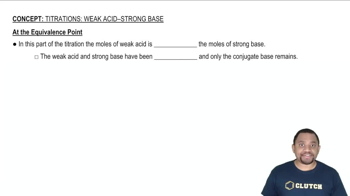Here are the essential concepts you must grasp in order to answer the question correctly.
Titration
Titration is a quantitative analytical technique used to determine the concentration of a solute in a solution. In this process, a solution of known concentration (the titrant) is gradually added to a solution of unknown concentration until the reaction reaches its equivalence point, where stoichiometrically equivalent amounts of reactants have reacted. This technique is commonly used in acid-base reactions to find the concentration of an acid or base.
Recommended video:
Equivalence Point
The equivalence point in a titration is the stage at which the amount of titrant added is stoichiometrically equivalent to the amount of substance in the sample being analyzed. For a monoprotic acid titrated with a strong base like NaOH, this point indicates that all the acid has reacted with the base. It is crucial for calculating the molar mass of the acid, as it provides the volume of base required to neutralize the acid.
Recommended video:
Molar Mass Calculation
Molar mass is the mass of one mole of a substance, typically expressed in grams per mole (g/mol). To calculate the molar mass of the unknown acid in this titration scenario, one must use the mass of the acid sample and the number of moles of acid that reacted, which can be determined from the volume and concentration of the NaOH used at the equivalence point. This relationship allows for the determination of the molar mass based on the formula: Molar Mass = mass of acid / moles of acid.
Recommended video:
Molar Mass Calculation Example
 Verified step by step guidance
Verified step by step guidance

